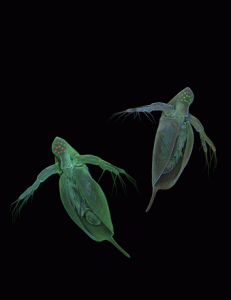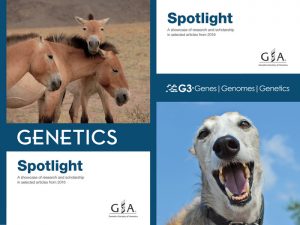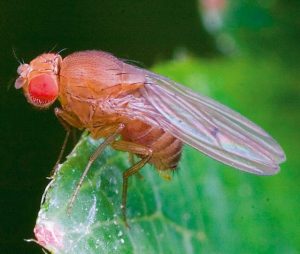Enter your address to receive notifications about new posts to your email.
Science & Publishing
-
Science & Publishing
May GENETICS Highlights
Check out the May issue of GENETICS by looking at the highlights or the full table of contents! ISSUE HIGHLIGHTS Bivariate analysis of age-related macular degeneration progression using genetic risk scores, pp. 119-133 Ying Ding, Yi Liu, Qi Yan, Lars G. Fritsche, Richard J. Cook, Traci Clemons, Rinki Ratnapriya, Michael L. Klein, Gonçalo R. Abecasis, Anand Swaroop, Emily…
-
Science & Publishing
New in G3: Daphnia genome assembly, mouse craniofacial shape, and Drosophila spermathecal cell fates
Check out the May issue of G3! Table of Contents Investigations Accurate Classification of Protein Subcellular Localization from High-Throughput Microscopy Images Using Deep Learning Tanel Pärnamaa, Leopold Parts G3: Genes, Genomes, Genetics May 2017 7: 1385-1392; DOI: https://doi.org/10.1534/g3.116.033654 Genotype Calling from Population-Genomic Sequencing Data Takahiro Maruki, Michael Lynch G3: Genes, Genomes, Genetics May 2017 7:…
-
Science & Publishing
The push-and-pull evolution of tandem-duplicated drug-resistance genes
Two highly similar genes that contribute to drug resistance in a pathogenic yeast have been co-evolving as tandem duplicates for the past 134 million years—while maintaining distinct functions. This is the conclusion of a paper in the April issue of GENETICS by Lamping et al. that examines the evolutionary effects of ectopic gene conversion. Evolutionary…
-
Science & Publishing
GSA Journals Spotlight 2016
The GSA Journals, GENETICS and G3: Genes|Genomes|Genetics, are proud to present our annual Spotlight booklets for research published in 2016. Each Spotlight is a showcase of the excellent research and scholarship published over the course of the year, along with a selection of striking images submitted by our authors. Browse the 2016 GENETICS Spotlight. Browse the 2016 G3 Spotlight. GENETICS SPOTLIGHT CITATIONS 2016 EDITORS’…
-
Science & Publishing
Three outstanding GENETICS articles honored with Editors’ Choice Awards
Congratulations to the winners of the Editors’ Choice Awards for outstanding articles published in GENETICS in 2016! The journal’s Editorial Board considered a diverse range of articles, finding many papers worthy of recognition. After much deliberation, they settled on one exceptional article for each of the three award categories: quantitative genetics, molecular genetics, and population and evolutionary…
-
Science & Publishing
Cause of fatal naked foal syndrome revealed
When a horse is born with naked foal syndrome (NFS), it will likely die early. This genetic skin condition affects the Akhal-Teke horse breed from Turkmenistan, which is known for its speed, endurance, and intelligence. Worryingly, the incidence of NFS seems to be increasing. Although breeders have been aware of NFS for over 75 years,…
-
Science & Publishing
Tools for transgenic studies in close relatives of D. melanogaster
Thanks to more than a hundred years of working with Drosophila melanogaster, geneticists have many powerful tools for precisely manipulating its genes. It has also become a model system for studying speciation and molecular evolution together with the other members of the melanogaster species group: D. simulans, D. mauritiana, D. yakuba, and D. santomea. However,…
-
Science & Publishing
Behind the cover: CRISPR in color
In the life of a butterfly, color is crucial. Color helps these flashy insects attract mates, avoid being spotted, or even signal to predators that they would make a bad meal. On the cover of the March issue of GENETICS is a close-up view of Junonia coenia, a butterfly with stunning blue eyespots on its…
-
Science & Publishing
Protein variance in tightly controlled developmental processes
Take two neighboring cells from the same tissue—cells that are about as identical as any could be. Despite their similarities, these two cells could actually vary massively in their transcriptome. The typical fate of an mRNA—the “transcript” in transcriptome—is to serve as a template to make a protein, but it isn’t clear that the differences…
-
Science & Publishing
Live long and prosper (under the right conditions)
Restricting calorie intake seems to promote longer lives in a wide range of organisms, from microbes to mammals. Some determined youth-seekers are already adopting reduced-calorie diets in an attempt to extend their lifespans. But it’s not clear yet that these anti-aging effects apply to humans, and the mechanisms by which they work in other organisms…
-
Science & Publishing
New in G3: unstable inheritance, chromosomal translocation, and meiotic silencing
Check out the April issue of G3! Table of Contents Mutant Screen Report Identification of Genes in Saccharomyces cerevisiae that Are Haploinsufficient for Overcoming Amino Acid Starvation Nancy S. Bae, Andrew P. Seberg, Leslie P. Carroll, Mark J. Swanson G3: Genes, Genomes, Genetics April 2017 7: 1061-1084; https://doi.org/10.1534/g3.116.037416 Investigations A Whole-Transcriptome Approach to Evaluating Reference…











